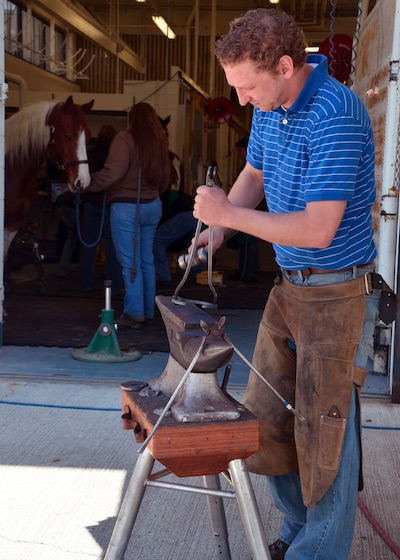The Worshipful Company of Farriers (WCF) was founded in 1356 when the mayor of London called the city’s farriers together and established the trade as a fellowship. Over the centuries the United Kingdom group has evolved and today represents an elevated level of excellence among farriers.
The highest level of achievement within the WCF is the fellow. Last week, American Travis Burns earned this elite achievement.
According to David Goodall, WCF registrar, there currently are 202 people who earned a FWCF, and only 37 who are still alive. Only five others based in the United States hold this distinction: Doug Butler, David Duckett, Chris Gregory, Mike Miller and Mike Wildenstein (earned with honors).
Burns, a lecturer and the chief of farrier services at Virginia-Maryland College of Veterinary Medicine (VMCVM), ventured to England last week to take the exam. He arrived in England and used a day prior to the examination to tour the facilities and practice in the forge at the Defence Animal Centre in Melton Mowbray. Illinois farrier Vern Powell joined him on the trip to help navigate and be his striker. Powell is the chairman of the American Farrier's Association (AFA) Cultural Exchange, which organizes and supervises an exchange of farriers between the AFA and England.
“Ben Howson picked us up at the airport and got us to Melton Mowbray. Robin Hayden, AWCF, and Chris McCabe, AWCF, both British Army Farriers, were great hosts,” says Burns. “Chris went above and beyond to ensure I had all the supplies and tools needed to take the exam, and feel comfortable in a new environment.”
The daylong examination involved his presentation of a research project and 25-minute defense of it against a team of two farriers (Andrew Poynton and Stephen Newman) and a veterinarian (Andy Matthews). Burns’ research project was on “Histological Characterization of the Laminar Interface.”
“More specifically, we looked at laminar morphology to determine if it is different histologically between horses with and without a crena,” he says. “The conclusion is that there is an aberration associated with a crena.”
Next, the examiners gave him a topic, in which he had an hour to prepare a 20-minute presentation and 25-minute question-and-answer session. Burns also provided a shoe display, which the examiners asked further questions about.
The next day, Burns and the other candidates were presented with a horse with a lameness issue/conformational defect. Working with the veterinarian, they were required to develop a shoeing plan for the horse and then carry it out.
“It’s a recent change to the FWCF exam,” says Burns. “Historically, candidates were asked to fit a therapeutic shoe to a cadaver limb.”

Travis Burns. Image courtesy of VMCVM. |
Burns credits his day-to-day work to help him prepare for this examination, adding that it mimics everyday life in a veterinary teaching hospital or referral clinic well.
“It gives you the ability to showcase what you do on a daily basis. I featured shoes that I use on a day-to-day basis, not necessarily all handmades,” he says. “There were three handmade steel shoes, three hand forged aluminum shoes and the rest were modern materials that were modified. I had one with a fetlock brace on it. They want to know what you do, not necessarily see an English tool and fullered shoe.
“I’m very lucky to be at a university. It is common for me to be quizzed by other farriers, veterinarians and vet students. You never know what is going to come into that clinic every day, so you can be presented with a case in which you have to find solutions as a team.”
Burns says to pass this exam, you will need the help of others. For example, his research project benefited from assistance from VMCVM faculty Dr. Scott Pleasant and Dr. Tom Cecere, as well as histology technician Kelli Hall. David Duckett, FWCF, was instrumental in providing encouragement and advice about the examination.
Conducting Research
An advocate for farrier-driven research, Burns encourages industry members to participate in research — not just for the FWCF examination.
“Performing research can be anything from retrospective studies, photographing horses throughout a shoeing cycle to describe the uses, benefits and changes of using a shoe,” he says. “It doesn’t have to be complex and costly.”
For more advanced research, he says there are resources available for interested farriers. The first step to a research project, he reminds, is coming up with a question you want answered. Don’t simply jump into the project, though.
“Next, go to the literature and make sure that hasn’t been answered,” he says. “This is one of the biggest problems I see. Farriers often come to me and discuss research ideas that they want to conduct. It is not uncommon then to find resources that have already answered that question when doing a literature review.”
He says farriers can have a difficult time finding the appropriate literature. He recommends internet resources (Google Scholar and PubMed) and local universities.
“Colleges and universities have libraries, which oftentimes you can enter for free,” he says. “You can pull the appropriate document, study or whatever resource you need. You will need to spend the amount of time to find it.”
For people to build relationships with to conduct research, Burns recommends the librarian at the closest college or university. They can help you in how to find the preliminary resources you may need. Also, you may consider reaching out to the faculty of university programs, like animal sciences or vet schools that could lend support.
Besides his work at VMCVM, Burns also is a certified journeyman farrier with therapeutic and education endorsements. He is a board member of the American Farrier’s Association, the Northeast Association of Equine Practitioners and serves on the advisory board of American Farriers Journal. Not one to rest on laurels, he’s looking for the next challenge, which may be forging competitions.








Post a comment
Report Abusive Comment